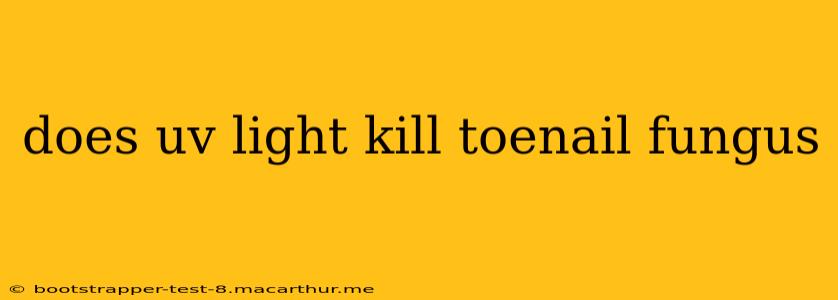Does UV Light Kill Toenail Fungus? A Comprehensive Look at Treatments
Fungal toenail infections, or onychomycosis, are a common problem affecting millions. While many seek a quick fix, the effectiveness of UV light in treating toenail fungus is a complex issue. This article explores the science behind UV light therapy, its potential benefits and limitations, and offers insights into more established treatment options.
What is Onychomycosis (Toenail Fungus)?
Before diving into UV light's role, it's crucial to understand the condition. Onychomycosis is a fungal infection that affects the toenails, causing discoloration (yellowing, browning, or blackening), thickening, crumbling, and sometimes pain or discomfort. Several types of fungi can cause this infection, and it often thrives in warm, moist environments.
Does UV Light Kill Toenail Fungus?
The short answer is: it's not a primary or consistently effective treatment. While UV light, specifically UVB light, has some antifungal properties, its penetration depth is limited. It may affect the surface of the nail, but it's unlikely to reach the deeper layers where the infection often resides. Therefore, using UV light alone is unlikely to completely eradicate the fungus.
What are the Limitations of UV Light for Toenail Fungus?
Several factors limit the effectiveness of UV light in treating toenail fungus:
- Limited Penetration: UVB rays don't penetrate deeply into the nail, making it ineffective against deeply embedded fungal infections.
- Inconsistent Results: Studies show inconsistent results, with some individuals showing minimal improvement, while others see no change.
- Potential for Skin Damage: Overexposure to UV light can damage the skin surrounding the affected nail, leading to sunburn or other complications.
- Not a Standalone Treatment: UV light is rarely used as a standalone treatment for toenail fungus by medical professionals.
Are There Other Effective Treatments for Toenail Fungus?
Yes, several effective treatments are available for toenail fungus:
- Antifungal Topical Medications: These creams or ointments are applied directly to the affected nail. They are most effective in early-stage infections.
- Oral Antifungal Medications: These pills are prescribed by doctors for more severe or widespread infections. They require a longer treatment period and may have potential side effects.
- Laser Therapy: Laser therapy uses a specific wavelength of light to target and kill the fungus. It's a more advanced treatment option, showing promising results in some studies. However, it is also not a guaranteed solution and can be costly.
What are the Home Remedies for Toenail Fungus?
While home remedies can help improve the appearance of your nails, these alone aren't often curative. Some common approaches include:
- Good hygiene: Keep nails clean and dry.
- Tea tree oil: Some studies suggest that tea tree oil may have antifungal properties. However, it's not a proven cure for toenail fungus.
- Vicks VapoRub: This is sometimes used as a home remedy, but its effectiveness isn't scientifically proven.
When Should I See a Doctor for Toenail Fungus?
It's always best to consult a doctor or podiatrist if you suspect you have toenail fungus. They can properly diagnose the condition and recommend the most appropriate treatment based on the severity of the infection and your individual health status. Delaying treatment can allow the infection to worsen, making it harder to treat effectively.
Disclaimer: This information is for educational purposes only and should not be considered medical advice. Always consult a healthcare professional for diagnosis and treatment of any medical condition.
